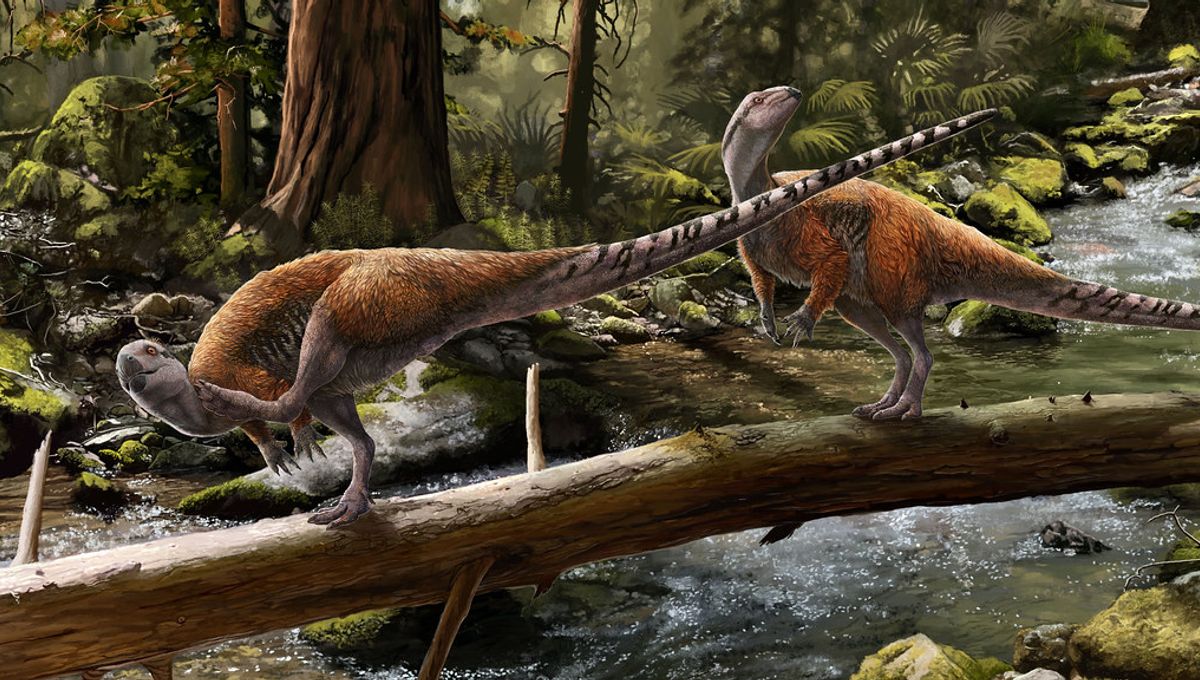
A new species of dinosaur called Vectidromeus insularis has been discovered on the Isle of Wight, the UK’s dinosaur island. It’s a big name for a critter that was adorably small – about the size of a chicken – but it also represents the second member of this dinosaur family to be found on the island. This suggests Europe may have had its own family of small herbivores that were distinct from Asian and North American ones.
Vectidromeus is a member of the hypsilophodont family of small, bipedal, plant-eating dinosaurs that lived around 125 million years ago. Although the new fossil is pretty small, it is believed to be a juvenile, which means the species may have been somewhat larger than the current specimen suggests.
This new species of dinosaur can boast some famous contemporaries. Vectidromeus would have been running around the forests of the Lower Cretaceous period alongside early tyrannosaurs, spinosaurs, and Iguanodon. But it also has famous relatives who have been significant in not only the history of palaeontology but for the history of science more generally.
Vectidromeus is closely related to Hypsilophodon foxii, which was also discovered on the Isle of Wight. During the 19th century, Hypsilophodon was among the first dinosaurs to be described due to its relatively complete remains. Like its newly identified relative, Hypsilophodon foxii was small and thin and had bird-like hindlimbs.
These features made this family useful for scientists interested in evolution and resulted in Thomas Henry Huxley, the famous Victorian biologist referred to as “Darwin’s bulldog”, using a hypsilophodont as evidence that birds evolved from dinosaurs.
Although Hypsilophodon and Vectidromeus were both found on the dino-island, they were not alive at the same time. This is because the former was recovered from higher up in the rocks, suggesting it was around 2 to 3 million years younger.
“Paleontologists have been working on the Isle of Wight for more than a century, and these fossils have played an important role in the history of vertebrate paleontology”, Dr Nicholas Longrich, from the Milner Centre for Evolution at the University of Bath, said in a statement. “But we’re still making new discoveries about the dinosaur fauna as the sea erodes new fossils out of the cliffs.”
The reason why new dinosaurs keep appearing on the Isle of Wight is because its Cretaceous strata are extremely thick (hundreds of meters thick) and may cover several million years. Although scientists still disagree on how old they are, it is possible that the fossils being recovered on the island come from a whole series of ecosystems, each of which had its own set of species.
“Working with the amateur community is really important,” Longrich added. “It’s good to have a diverse team; everyone brings something different to the table. These guys have spent their lives collecting and preparing these fossils, they know details about the rock, the geology, and the bone that nobody else does. Everyone sees different pieces of the puzzle.”
Amateur collectors have made a huge difference to our understanding of fossils on the island. “Vectidromeus is the seventh new species of dinosaur to be discovered in the last four years. This is all down to the amateur collectors,” the study’s co-author Professor Dave Martill from the University of Portsmouth explained.
“It is utterly bizarre that so many new dinosaurs are being discovered on the Isle of Wight.”
Dr Martin Munt, another co-author, and curator of Dinosaur Isle Museum added: “This exciting new find is the latest in a line of new discoveries from the Isle of Wight.
“We are enjoying an amazing time of collaboration between collectors, researchers and the museum. New finds are being made on the coast, in private collections, and the museum stores.
“The museum’s mission is to try and ensure as many new finds remain here on the Island for the benefit of our Island community; we anticipate this dinosaur to be on display at the museum for the October school holidays.”
Reclassifying an old species
For some time there has been a debate within the scientific community over which species should be part of the hypsilophodont family. Various small, plant-eating dinosaurs had been added to it over the years, but revisions to their family tree led to them being reclassified to other branches of the family tree. This left Hypsilophodon being the sole member of this family, until now.
“We had a curious situation where one of the first dinosaur families to be recognized had just one species. And now, we have two”, Longrich stated.
Interestingly, neither of these species are closely related to anything found in Asia, North America, or in the Southern Hemisphere.
“We’re still piecing together how all these dinosaurs are related, and how dinosaurs moved between continents. After Pangaea broke up, there was a lot of isolation, leading to different kinds of dinosaurs evolving on each continent.”
The study is published in Cretaceous Research.
Source Link: New Chicken-Sized Dinosaur Discovered On The UK’s Dino Island